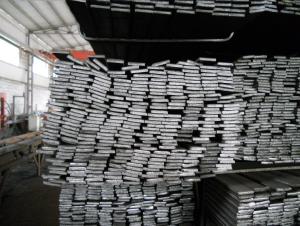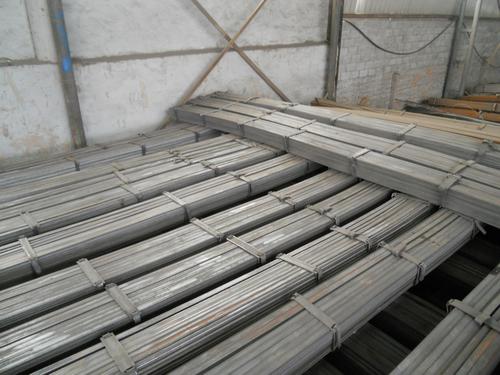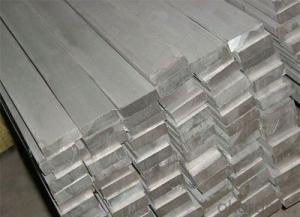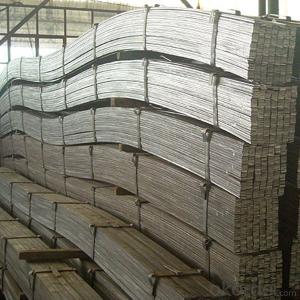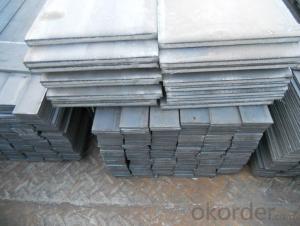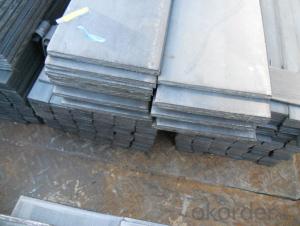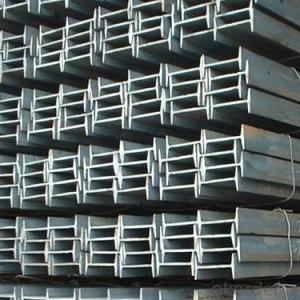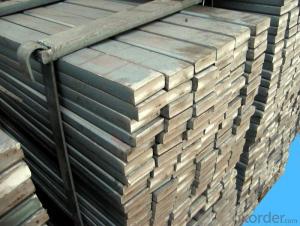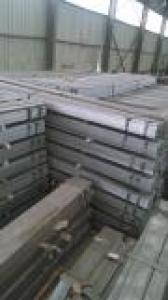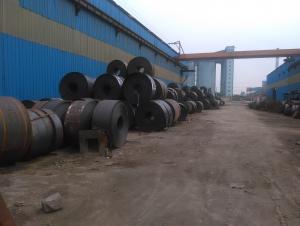Hot Rolled Steel Flat Bars for Construction
- Loading Port:
- Tianjin
- Payment Terms:
- TT or LC
- Min Order Qty:
- 25 m.t.
- Supply Capability:
- 100000 m.t./month
OKorder Service Pledge
OKorder Financial Service
You Might Also Like
Product Description:
OKorder is offering Hot Rolled Steel Flat Bars for Construction at great prices with worldwide shipping. Our supplier is a world-class manufacturer of steel, with our products utilized the world over. OKorder annually supplies products to European, North American and Asian markets. We provide quotations within 24 hours of receiving an inquiry and guarantee competitive prices.
Product Applications:
Hot Rolled Steel Flat Bars for Construction are ideal for structural applications and are widely used in the construction of buildings and bridges, and the manufacturing, petrochemical, and transportation industries.
Product Advantages:
OKorder's Hot Rolled Steel Flat Bars for Construction are durable, strong, and resist corrosion.
Main Product Features:
· Premium quality
· Prompt delivery & seaworthy packing (30 days after receiving deposit)
· Corrosion resistance
· Can be recycled and reused
· Mill test certification
· Professional Service
· Competitive pricing
Product Specifications:
Manufacture: Hot Rolled Steel Flat Bars for Construction
Grade: Q195 – 235
Certificates: ISO, SGS, BV, CIQ
Length: 6m – 12m, as per customer request
Packaging: Export packing, nude packing, bundled
Chemical composition of Q235
Alloy No | Grade | Element(%) | ||||
C
| Mn
| S
| P
| Si
| ||
Q235
|
B
|
0.12—0.20 |
0.3—0.7 |
≤0.045 |
≤0.045
|
≤0.3
|
Physical properties of Q235
Alloy No | Grade | Yielding strength point(Mpa) | Tensile strength (Mpa) | Elongation after fracture(%) | ||||||
Thickness (mm) | Thickness (mm) | |||||||||
≤16 | >16--40 | >40--60 | >60--100 | ≤16 | >16--40 | >40--60 | >60--100 | |||
≥ | ≥ | |||||||||
Q235 |
B |
235 |
225 |
215 |
205 |
375--500 |
26 |
25 |
24 |
23 |
FAQ:
Q1: Why buy Hot Rolled Steel Flat Bars for Construction from OKorder.com?
A1: All products offered byOKorder.com are carefully selected from China's most reliable manufacturing enterprises. Through its ISO certifications, OKorder.com adheres to the highest standards and a commitment to supply chain safety and customer satisfaction.
Q2: What is the normal tolerance of Hot Rolled Mild Steel Angle Beams for Structures and for Buildings?
A2: Normally 3%-5%, but we can also produce the goods according to the customers' requests.
Q3: How soon can we receive the product after purchase?
A3: Within three days of placing an order, we will begin production. The specific shipping date is dependent upon international and government factors, but is typically 7 to 10 workdays.
Images:
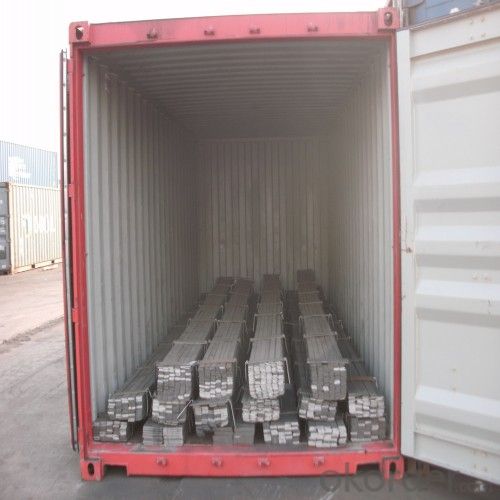
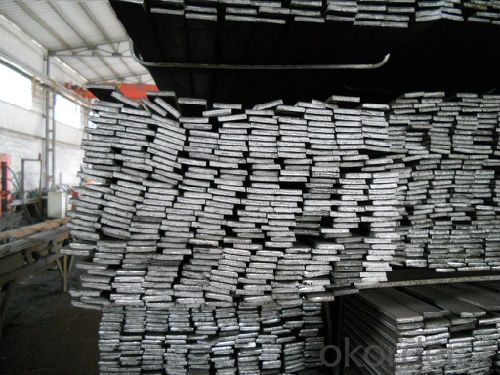
- Q: Are steel flat bars suitable for making industrial equipment?
- Steel flat bars are well-suited for the production of industrial equipment. Renowned for their strength, durability, and versatility, these bars are highly suitable for a range of applications within the industrial sector. They can be utilized to create frames, supports, and structures for machinery and equipment. Furthermore, steel flat bars possess exceptional load-bearing capabilities, making them an ideal choice for heavy-duty industrial equipment. Moreover, their ease of welding, cutting, and shaping enables them to be tailored to specific design requirements, allowing for customization and flexibility in equipment manufacturing. Overall, steel flat bars are a dependable and extensively utilized material in the fabrication of industrial equipment, owing to their robustness, longevity, and adaptability.
- Q: How do you prevent distortion or warping on steel flat bars during machining?
- There are several measures that can be taken to prevent distortion or warping on steel flat bars during machining. These include: 1. Choosing the appropriate steel material with suitable mechanical properties for the machining process. Opting for steel with a low carbon content can decrease the possibility of distortion. 2. Applying stress relief annealing before machining to reduce any residual stresses within the steel. This involves heating the steel to a specific temperature and allowing it to cool slowly, minimizing distortion. 3. Using adequate fixturing methods to securely hold the steel flat bars in place during machining. This prevents movement or flexing that could cause distortion. Effective clamping using vices or similar means can be effective. 4. Employing proper machining techniques to avoid distortion. It is important to avoid excessive cutting forces or high cutting speeds that generate excessive heat. Using appropriate cutting tools, feeds, and speeds helps maintain control over the machining process. 5. Ensuring effective cooling during machining by using coolants or lubricants. This dissipates heat generated during the process, aiding in preventing distortion. 6. Planning the machining sequence to minimize heat accumulation in localized areas. Distributing machining operations evenly across the steel flat bar helps maintain its shape and minimizes the risk of warping. By implementing these preventative measures, distortion or warping on steel flat bars during machining can be significantly reduced. This results in better quality and dimensional accuracy of the final product.
- Q: Are steel flat bars recyclable?
- Yes, steel flat bars are recyclable. Steel is one of the most commonly recycled materials in the world due to its inherent properties. Steel can be melted down and repurposed multiple times without losing its quality or strength. Recycling steel flat bars not only helps conserve natural resources but also reduces energy consumption and greenhouse gas emissions compared to producing new steel from raw materials. Recycling facilities and scrap yards accept steel flat bars for recycling, making it an environmentally friendly option for disposing of or repurposing these materials.
- Q: How do steel flat bars perform in corrosive or acidic environments?
- Corrosive or acidic environments can affect the performance of steel flat bars, depending on the type of steel and the specific properties of the environment. For instance, stainless steel flat bars offer high resistance to corrosion in most acidic or corrosive environments. This is due to their chromium content of at least 10.5%, which forms a protective oxide layer on the steel surface, preventing further corrosion. Moreover, stainless steel flat bars can be alloyed with elements like nickel or molybdenum to further enhance their corrosion resistance. On the other hand, carbon steel flat bars are not as resistant to corrosion. They are prone to rust and corrosion in acidic or corrosive environments because they lack the protective oxide layer present in stainless steel. In such cases, additional measures like galvanization or coating the flat bars with corrosion-resistant materials may be necessary for protection. To determine the performance of steel flat bars in corrosive or acidic conditions, it is crucial to consider the specific type of steel used and the nature of the environment. Seeking advice from experts or referring to corrosion resistance charts can provide more precise information regarding the suitability of steel flat bars in different environments.
- Q: What are the common factors affecting the price of steel flat bars?
- There are several common factors that can affect the price of steel flat bars. 1. Raw material costs: The cost of the raw materials used to produce steel, such as iron ore, coal, and scrap metal, can greatly impact the price of steel flat bars. Fluctuations in these raw material prices can lead to significant changes in the overall cost of production and, subsequently, the price of steel flat bars. 2. Supply and demand: Like any other commodity, the supply and demand dynamics play a crucial role in determining the price of steel flat bars. If there is a high demand for steel flat bars and limited supply, the price is likely to increase. Conversely, if the supply exceeds the demand, prices may decrease. 3. Manufacturing and processing costs: The cost of manufacturing and processing steel flat bars can also impact their price. This includes expenses related to labor, energy, transportation, and other production-related costs. Any changes in these costs, such as increased wages or electricity prices, can affect the final price of steel flat bars. 4. Market competition: The level of competition within the steel industry can influence the price of steel flat bars. When there are many suppliers offering similar products, the market becomes more competitive, which can lead to lower prices. Conversely, if there are fewer competitors, prices may increase. 5. Government regulations and trade policies: Government regulations and trade policies, such as import tariffs or quotas, can have a significant impact on the price of steel flat bars. These policies can restrict or promote the import and export of steel, which can affect the overall supply and demand dynamics and subsequently influence prices. 6. Economic conditions: The overall state of the economy can also affect the price of steel flat bars. During periods of economic growth and high construction activity, the demand for steel flat bars tends to increase, leading to higher prices. Conversely, during economic downturns or recessions, demand may decrease, resulting in lower prices. It's important to note that the combination of these factors can vary depending on the specific market and region. Additionally, external factors such as natural disasters, geopolitical events, and currency exchange rates can also impact the price of steel flat bars.
- Q: How do you prevent twisting of steel flat bars during welding?
- To prevent twisting of steel flat bars during welding, there are several measures you can take: 1. Proper preparation: Ensure that the flat bars are clean and free of any contaminants, such as oil, grease, or rust. Use a wire brush or grinder to remove any surface impurities. 2. Proper clamping: Securely clamp the flat bars in place before welding. Use sturdy clamps or magnetic welding fixtures to hold the bars firmly in position, preventing any movement or twisting during the welding process. 3. Tack welding: Prior to performing the full weld, use tack welds to temporarily hold the flat bars together. This will help maintain their alignment and prevent twisting while the final weld is being applied. 4. Weld sequence: Adopt a strategic weld sequence that minimizes heat distortion and potential twisting. Avoid welding a continuous bead along the entire length of the flat bars, as this can generate excessive heat and cause distortion. Instead, alternate between different sections or weld in short intervals, allowing each area to cool before proceeding. 5. Minimize heat input: Control the heat input during welding by using the appropriate welding technique and adjusting the welding parameters. High heat levels can cause the steel to expand and contract, leading to twisting. Employing techniques such as pulse welding or reducing the amperage can help control heat input and minimize the risk of twisting. 6. Preheating and post-weld heat treatment: For thicker or more susceptible steel flat bars, preheating the material before welding can help reduce the risk of twisting. Additionally, performing post-weld heat treatment can relieve residual stresses and prevent distortion. 7. Slow cooling: Allow the welded flat bars to cool slowly and naturally after welding. Rapid cooling, such as through water quenching, can induce additional stresses and contribute to twisting. Avoid abrupt temperature changes and provide adequate time for the welded bars to cool down gradually. By implementing these preventive measures, you can significantly reduce the risk of twisting in steel flat bars during welding, ensuring a successful and distortion-free weld.
- Q: What are the applications of steel flat bars in the automotive industry?
- Steel flat bars are extensively utilized in the automotive industry due to their wide range of applications and numerous benefits. Some of the primary uses of steel flat bars in the automotive sector include: 1. Chassis and Frame Components: Automobiles often incorporate steel flat bars in the construction of chassis and frame components. These bars offer the necessary strength and rigidity to support the vehicle's weight and endure various forces and vibrations. 2. Suspension Systems: Suspension systems, including leaf springs and torsion bars, are fabricated using steel flat bars. These components assist in absorbing shocks and vibrations, thereby enhancing the overall ride quality and stability of the vehicle. 3. Braking Systems: Steel flat bars are integral to the construction of various braking system components, such as brake shoes and brake rotors. They provide the essential strength and durability to withstand the high temperatures and pressures associated with braking. 4. Safety Features: Steel flat bars find application in the manufacturing of safety features like roll bars and roll cages. These components offer additional protection to the vehicle's occupants in the event of a rollover or collision, thereby improving overall safety. 5. Bumpers and Grilles: Automobile bumpers and grilles are often fabricated using steel flat bars. These bars provide impact resistance and safeguard the engine and other vital components located at the front and rear ends of the vehicle. 6. Body Panels: Steel flat bars are extensively used in the construction of body panels, such as door frames, roof rails, and window frames. Their strength and stability contribute to maintaining the structural integrity of the vehicle's body. 7. Exhaust Systems: The manufacturing of exhaust systems, including exhaust pipes and mufflers, incorporates steel flat bars. These bars offer high-temperature resistance, corrosion resistance, and durability, ensuring efficient exhaust gas flow and reducing noise levels. In conclusion, steel flat bars play a vital role in the automotive industry by providing strength, durability, and reliability to various components and systems. They significantly contribute to the overall performance, safety, and longevity of automobiles.
- Q: Can steel flat bars be used for making storage cabinets?
- Yes, steel flat bars can be used for making storage cabinets. Steel flat bars are sturdy and durable, making them suitable for constructing storage cabinets that can withstand heavy loads. They offer excellent structural integrity and can be easily welded or bolted together to create a stable and secure storage solution. Additionally, steel flat bars are resistant to rust and corrosion, ensuring the longevity of the storage cabinets. Therefore, using steel flat bars for making storage cabinets is a practical choice that can provide strength, durability, and a professional appearance.
- Q: How can I prevent rusting on steel flat bars?
- To prevent rusting on steel flat bars, you can take several preventive measures. Firstly, ensure that the flat bars are properly cleaned and free from any dirt, debris, or moisture before storage or use. This can be done by wiping them down with a dry cloth or using a mild soap and water solution if necessary. Next, you should apply a protective coating or finish to the steel flat bars. There are various options available such as painting, powder coating, or applying a rust-resistant primer. These coatings act as a barrier between the steel and the environment, preventing moisture and oxygen from reaching the metal surface and causing rust to form. Additionally, you can consider using corrosion-resistant materials for the construction of your steel flat bars. Stainless steel, for instance, contains chromium which forms a protective layer on the surface, making it highly resistant to rusting. Galvanized steel is another option, as it is coated with a layer of zinc to provide excellent corrosion resistance. Proper storage is also crucial to prevent rusting. Keep the steel flat bars in a dry and well-ventilated area, away from any moisture or humidity. If stored outdoors, ensure that they are covered and protected from rain and other elements. Regular maintenance is essential as well. Inspect the flat bars periodically for any signs of rust or damage. If any rust spots are detected, remove them immediately using a wire brush or sandpaper, and apply a touch-up coating to prevent further corrosion. By following these preventive measures, you can significantly reduce the chances of rusting on steel flat bars and prolong their lifespan.
- Q: Can steel flat bars be used in electrical or electronic equipment?
- Yes, steel flat bars can be used in electrical or electronic equipment. Steel flat bars are often used as a mounting or support component in electrical or electronic equipment due to their strength and durability. They provide stability and structural integrity to the equipment, especially in applications where weight or load-bearing capacity is important. Additionally, steel flat bars can also be used as conductive elements in certain electrical or electronic systems, as they have good electrical conductivity properties. However, it is important to note that steel is a conductor of electricity, so proper insulation and grounding techniques should be followed to prevent any electrical hazards.
Send your message to us
Hot Rolled Steel Flat Bars for Construction
- Loading Port:
- Tianjin
- Payment Terms:
- TT or LC
- Min Order Qty:
- 25 m.t.
- Supply Capability:
- 100000 m.t./month
OKorder Service Pledge
OKorder Financial Service
Similar products
Hot products
Hot Searches
Related keywords

